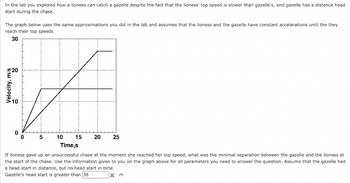
College Physics
11th Edition
ISBN: 9781305952300
Author: Raymond A. Serway, Chris Vuille
Publisher: Cengage Learning
expand_more
expand_more
format_list_bulleted
Concept explainers
Topic Video
Question

Transcribed Image Text:In the lab you explored how a lioness can catch a gazelle despite the fact that the lioness' top speed is slower than gazelle's, and gazelle has a distance head
start during the chase.
The graph below uses the same approximations you did in the lab and assumes that the lioness and the gazelle have constant accelerations until the they
reach their top speeds.
30
Velocity, mi
✔20
0
0
5
15 20
Time,s
If lioness gave up an unsuccessful chase at the moment she reached her top speed, what was the minimal separation between the gazelle and the lioness at
the start of the chase. Use the information given to you on the graph above for all parameters you need to answer the question. Assume that the gazelle had
a head start in distance, but no head start in time.
Gazelle's head start is greater than 35
10
25
m
Expert Solution
This question has been solved!
Explore an expertly crafted, step-by-step solution for a thorough understanding of key concepts.
This is a popular solution
Trending nowThis is a popular solution!
Step by stepSolved in 3 steps with 2 images

Knowledge Booster
Learn more about
Need a deep-dive on the concept behind this application? Look no further. Learn more about this topic, physics and related others by exploring similar questions and additional content below.Similar questions
- A motorist starts from rest and traveled as seen in the speed-time graph. The total distance traveled and the average velocity in m/s for the distance traveled is 1.5 3.0 4.5 6.0 7.5 Time in minutes Select one: O a. 7.5 km, 4.5 m/s b. 10 km, 1.5 m/s c. 4.5 km, 10 m/s Reply... Speed in km/h :arrow_forwardA motorist drove from Bristol to Bath at an average speed of 40 mph and then from Bath to Chippenham at an average spped of 30 mph. What was her average speed for the whole journey? A. 35 mph B. 36 mph C. 70 mph D. need more informationarrow_forwardThe figure below shows velocity-versus-time graphs for two objects, A and B. What can we say about the distance between objects A and B? Vy The distance between A and B is always increasing. The distance between A and B first decreases and then increases. The distance between A and B is always decreasing. The distance between A and B first increases and then decreases. The distance between A and B remains constant. O O O O Oarrow_forward
- A car is going 29.0 m/s when it begins to slow and comes to a stop in 100 meters. What was the acceleration of the car? a. -3.05 m/s² -4.21 m/s² O b. C. d. -5.01 m/s² *3.05 m/s² e. 4.21 m/s²arrow_forwardCan you demonstrate with a setup, solve and review?arrow_forwardThe initial velocity of an object is 10 m/s. The object slows down until it finally stops: A. If the acceleration is - 2 . What time did it take ms2 for the object to stop? B. What is the final position of the object?arrow_forward
- Rory is pushing Amy in a wheelbarrow race. Good times! If Rory goes from rest to 3.2 m/s in 6.0 seconds accelerating uniformly:arrow_forwardThe position graph shows a dog slowly sneaking up on a squirrel, then putting on a burst of speed.a. For how many seconds does the dog move at the slower speed?b. Draw the dog’s velocity-versus-time graph. Include a numerical scale on both axes.arrow_forwardHelp me pleasearrow_forward
- A person jogs 45 m east and then 15m west. It takes 15 seconds to complete the jog. Calculate the speed of the person . Choose the correct answer with the correct unit. A. 4 m/s B. 4 mph C. 3 m/s D. 5m/sarrow_forwardYou are traveling at 1 m s North on your bike when you realize you are going to be late for school. You pump into high gear and accelerate at 2 m s 2 . What is your instantaneous velocity after 3s?arrow_forwardAn object moves in one dimension, and its velocity versus time is shown in the graph. Express your answers in m/s2. A. What is the average acceleration between the times 0 s and 20 s? B. What is the average acceleration between the times 20 s and 50 s? C. What is the average acceleration between the times 50 s and 70 s? D. What is the average acceleration between the times 0 s and 100 s?arrow_forward
arrow_back_ios
SEE MORE QUESTIONS
arrow_forward_ios
Recommended textbooks for you
 College PhysicsPhysicsISBN:9781305952300Author:Raymond A. Serway, Chris VuillePublisher:Cengage Learning
College PhysicsPhysicsISBN:9781305952300Author:Raymond A. Serway, Chris VuillePublisher:Cengage Learning University Physics (14th Edition)PhysicsISBN:9780133969290Author:Hugh D. Young, Roger A. FreedmanPublisher:PEARSON
University Physics (14th Edition)PhysicsISBN:9780133969290Author:Hugh D. Young, Roger A. FreedmanPublisher:PEARSON Introduction To Quantum MechanicsPhysicsISBN:9781107189638Author:Griffiths, David J., Schroeter, Darrell F.Publisher:Cambridge University Press
Introduction To Quantum MechanicsPhysicsISBN:9781107189638Author:Griffiths, David J., Schroeter, Darrell F.Publisher:Cambridge University Press Physics for Scientists and EngineersPhysicsISBN:9781337553278Author:Raymond A. Serway, John W. JewettPublisher:Cengage Learning
Physics for Scientists and EngineersPhysicsISBN:9781337553278Author:Raymond A. Serway, John W. JewettPublisher:Cengage Learning Lecture- Tutorials for Introductory AstronomyPhysicsISBN:9780321820464Author:Edward E. Prather, Tim P. Slater, Jeff P. Adams, Gina BrissendenPublisher:Addison-Wesley
Lecture- Tutorials for Introductory AstronomyPhysicsISBN:9780321820464Author:Edward E. Prather, Tim P. Slater, Jeff P. Adams, Gina BrissendenPublisher:Addison-Wesley College Physics: A Strategic Approach (4th Editio...PhysicsISBN:9780134609034Author:Randall D. Knight (Professor Emeritus), Brian Jones, Stuart FieldPublisher:PEARSON
College Physics: A Strategic Approach (4th Editio...PhysicsISBN:9780134609034Author:Randall D. Knight (Professor Emeritus), Brian Jones, Stuart FieldPublisher:PEARSON

College Physics
Physics
ISBN:9781305952300
Author:Raymond A. Serway, Chris Vuille
Publisher:Cengage Learning

University Physics (14th Edition)
Physics
ISBN:9780133969290
Author:Hugh D. Young, Roger A. Freedman
Publisher:PEARSON

Introduction To Quantum Mechanics
Physics
ISBN:9781107189638
Author:Griffiths, David J., Schroeter, Darrell F.
Publisher:Cambridge University Press

Physics for Scientists and Engineers
Physics
ISBN:9781337553278
Author:Raymond A. Serway, John W. Jewett
Publisher:Cengage Learning

Lecture- Tutorials for Introductory Astronomy
Physics
ISBN:9780321820464
Author:Edward E. Prather, Tim P. Slater, Jeff P. Adams, Gina Brissenden
Publisher:Addison-Wesley

College Physics: A Strategic Approach (4th Editio...
Physics
ISBN:9780134609034
Author:Randall D. Knight (Professor Emeritus), Brian Jones, Stuart Field
Publisher:PEARSON